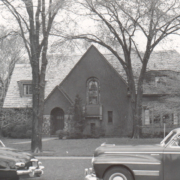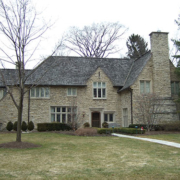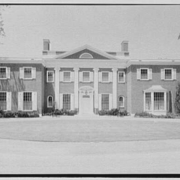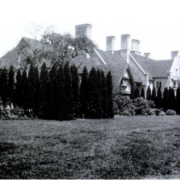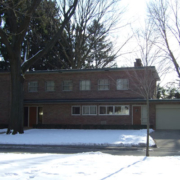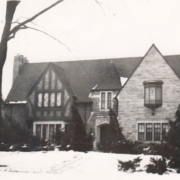Historical Architecture of Grosse Pointe – A Home Fit for an Architect
Having profiled the work of architect Leonard B. Willeke, and the highs and lows of his career, we wanted to conclude our research on this superb architect by profiling the two homes he created for himself – 1100 Berkshire and 1142 Bishop.
The year is 1922 and Willeke is in the midst of completing his initial design for the Oscar Webber mansion (to be located at 22 Webber place). Willeke’s career is soaring; having designed many beautiful creations for his clients Willeke turns his attention to creating a new home for himself and his wife Leona at 1100 Berkshire, Grosse Pointe Park.
The couple, along with their three-year-old son, had previously resided in an apartment located on Elmhurst Avenue, before moving, in 1920, to a new home he had designed on Moss Street, Highland Park. A couple of years after moving in Willeke’s career and income was such that he decided to build a larger residence for himself in Grosse Pointe Park. The decision, it is believed, not only made practical sense from a personal point of view, but also business sense – it would put him closer to the lots he had recently purchased on Balfour to create several speculative homes. (Between 1922 and 1929, he created 7 residences on Balfour that included 4 speculative homes).

Residence on Moss Street, Highland Park – Courtesy of Excellence in Architecture and Design by Thomas Brunk
1100 Berkshire
Willeke referred to the design of his new home as ‘Modern English’. The floor plan has a U-shaped configuration, which not only made it compact and convenient but also provided light and excellent air circulation throughout the house. Research from Thomas Brunk’s book ‘Leonard B. Willeke, Excellence in Architecture and Design’ states ‘Willeke designed the home with two main entrances – one at the front and the second at the side, each with direct access to the library’.
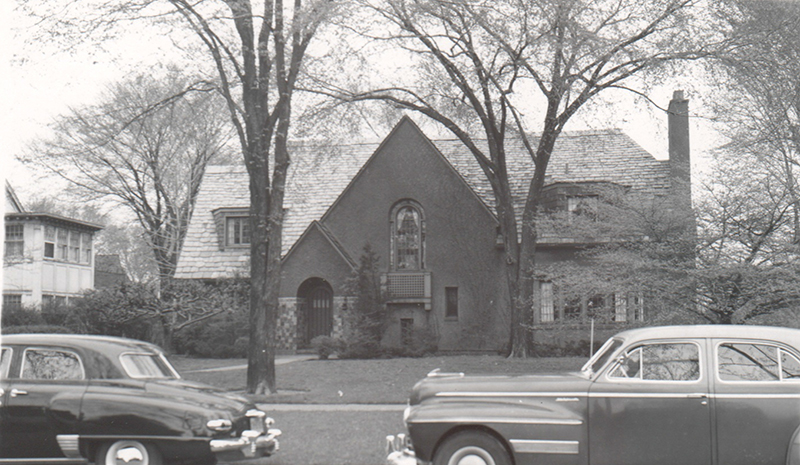
The research continues to describe the 2,974 sq ft home as having a mahogany paneled library, which served as Willeke’s consultation room. ‘The first floor features two levels. The lower level contains the vestibule, main hall, library and the living room, while the dining room, breakfast room, kitchen and living porch are raised (by one foot) and are situated along the back of the house’.
The main hall and living rooms have barrel-vaulted ceilings and were filled with walnut detail. Pewabic tile was used extensively throughout the house, while floral and animal motifs were present in much of the paneling and wall trim. The majority of the Pewabic tile is believed to have been custom made by the Pewabic Pottery. Research by Brunk suggests the ‘custom made tile incorporated special colors and glazes based on Willeke’s decorative scheme’.
The U shaped floor plan also provided the home with the space to feature a sleeping porch on the second floor rear elevation – as depicted in the photo below. Sleeping porches became popular at the turn of the 20th Century. Before the advent of air conditioning a sleeping porch provided an ideal space for sleeping in a screened and furnished area during the warmer summer months.
It is said that Willeke incorporated many special features and artistic designs – into his new residence – from the sketches he had compiled during his years of travel and study abroad. It was after all intended to be his final home.
Construction on Willeke’s new home began in November 1922, and the family moved in during the summer of 1923. Prior to moving into 1100 Berkshire Willeke wrote the following note to a fellow architect –
“Our New place is going to be a beauty, and is located in the finest residential suburb of Detroit, and is very unusual in appearance, done purposely, as it will attract every passerby even though it is very quiet and homelike in its quality, but the form color, and materials used are of the most unusual kind, this section if building up slowly with only five homes, and I expect to do all of my work in this locality for the next five years, and after that who cares, for I expect to clean up enough to quit thinking about money matter.”– Courtesy of ‘Leonard B. Willeke, Excellence in Architecture and Design’ by Thomas Brunk.
Sadly several years’ later, in 1932, money troubles, and the great depression resulted in Willeke having to move out of 1100 Berkshire. The family moved to a small apartment on Village Lane to weather the worst of the financial storm. Thankfully things began to improve in 1934 when the architect began to receive some small remodeling jobs followed by several new commissions.
1142 Bishop Road
In 1938 with his career back on track Willeke set about building himself a new home and studio at 1142 Bishop Road. Research from Brunk states that ‘while Willeke still owned the house on Berkshire, he no longer wished to live in a home that large’.

1142 Bishop – Courtesy of Excellence in Architecture and Design by Thomas Brunk

When designing his new 2,300 sq ft home on Bishop it is believed Willeke chose to pursue and investigate ‘an artistic and fresh design’ for his new home, incorporating his remarkable sensitivity for the use of materials, colors and textures. He selected to keep the cost of his new residence to under $14,000 (around $240,000 today) and despite wanting to use Pewabic tile throughout, he chose to proceed with less expensive tile to keep within his budget constraints. The home is particularly handsome, and is an excellent example of how his style evolved.
The Willeke’s had a long association with Grosse Pointe Park – aside from the many homes he designed throughout the community, the couple resided in the city for over fifty years.
We would like to thank Thomas Brunk for his wonderful research on Leonard B. Willeke. Without this work and his book – ‘An Excellence in Architecture’ and Design – the many details from this amazing designer’s career would have been lost.
*Photos courtesy of the Higbie Maxon Agney archives unless stated.
Written by Katie Doelle
Copyright © 2016 Katie Doelle

